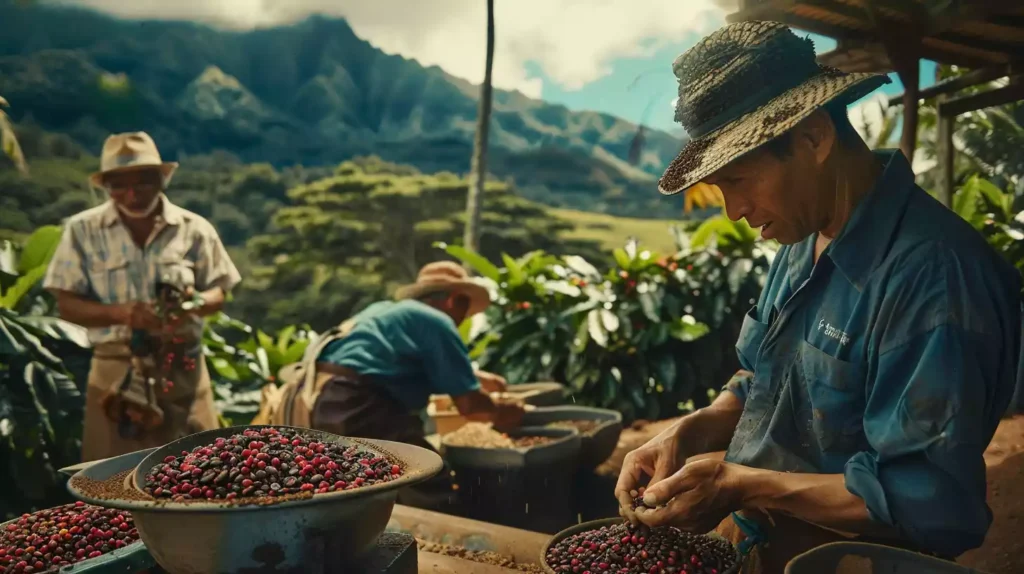If you know your coffee, you will know that Hawaiian coffee is a popular gourmet coffee. In fact, it is one of the world’s most limited, prized, and expensive coffees. However, Hawaiian coffee can be a minefield for those without any idea how to shop for one.
This is because many irresponsible sellers like to use the term ‘Hawaiian’ or ‘Kona’ coffee to lure unsuspecting buyers but serve them inferior coffee instead. Hawaiian coffee is also graded in many ways, further adding to the confusion.
How can you tell a good Hawaiian coffee from a bad one? How are Hawaiian coffee graded?
Hawaiian coffee could be graded by its bean shape, origin, bean size, moisture level, and also imperfections. Regular Hawaiian coffee-grade names include:
- Extra Fancy (Highest Grade)
- Fancy
- Number 1
- Select
- Prime
- No.3. (Lowest Quality)
This is a full, all-in guide explaining how Hawaiian coffee is graded and also why Hawaiian coffee is being graded this way.

What Is Hawaiian Coffee?
Hawaiian coffee is coffee beans grown in Hawaii, mainly on the Big Island and neighboring islands. Known for its smooth, well-balanced flavor, Hawaiian coffee is also one of the world’s priciest, reaching over $60 a pound. Varieties of Hawaiian coffee include Kona, Ka’u, Puna, or Maui.
Hawaiian coffee largely refers to the coffee beans grown in Hawaii and the islands on the Hawaii Island Chains. Hawaiian coffee could be separated into smaller varieties, such as Kona, Puna, Ka’u, Maui, and more.
Of these types, Kona is the most popular. Many drinks love Kona coffee’s taste, especially the notes of chocolate, nuts, and spice.
Hawaii’s coffee has a unique flavor, thanks to the volcanic soil and tropical climate. Hawaiian coffee is now thought to be the best-tasting in the world and has a smooth, well-balanced flavor.
Hawaiian coffee is also well-known for the way it is grown. Many farmers in Hawaii grow their coffee using organic and shade-grown methods, which helps protect the environment and keep the islands’ unique biodiversity.
As a result, Hawaiian coffee could be one of the priciest coffees in the world, rivaling even the Kopi Luwak coffee.
What is the Difference Between Organic Coffee Beans and Hawaiian Coffee Beans in Terms of Quality?
When it comes to quality organic coffee beans, the main difference between organic coffee beans and Hawaiian coffee beans lies in their origin. While organic coffee beans are grown without the use of synthetic pesticides or fertilizers, Hawaiian coffee beans are specifically grown in the volcanic soil of Hawaii, giving them a unique flavor profile.
Why Are Hawaiian Coffee Graded?
Hawaiian coffee is graded stringently to protect coffee farms and sellers. This is to ensure the standards for Hawaiian coffee remain high. Strong grading systems also ensure the name Hawaiian coffee does not get abused by unscrupulous marketers selling low-quality beans but masquerading as high-quality Hawaiian coffee.
Hawaiian coffee is graded stringently for many reasons. Some include ensuring only good coffee is sold as one. Another reason is to protect the name from being abused by unscrupulous marketers.
Keeping Hawaii Coffee Standards High
Hawaii coffee is one of the world’s most prized, expensive coffee. The price may be justified by several reasons, such as its limited annual production and demand.
However, the most important reason Hawaiian coffee remains at its high standard is that it is graded stringently. Hawaiian coffee is graded by many aspects, such as size, origin, shape, and imperfections.
This ensures that only the highest quality beans get to be labeled as Hawaiian coffee, ensuring a great coffee-drinking experience for drinkers.
Prevent Unscrupulous Sellers From Abusing The Name
Hawaii coffee’s reputation has resulted in a higher demand worldwide, with many paying top dollar to get a chance to sip some. This has not gone unnoticed by many unscrupulous sellers.
These sellers profited by selling a so-called ‘Hawaiian’ or ‘Kona’ coffee with little Hawaiian coffee beans.
Instead, they sell a ‘Hawaiian Blend,’ where the Hawaiian coffee beans are mixed up with coffee beans from other regions. The blend can sometimes be as low as 1:9, which means 10% Hawaiian beans and 90% other beans.
If you prefer to avoid buying these coffees, always look for ‘Estate’ Hawaiian coffee. These are 100% Hawaiian coffee beans, meaning you do get to taste the actual Hawaiian coffee, not some cheap blends.
What Are The Criteria Used To Grade Hawaiian Coffee?
The criteria for grading Hawaiian Coffee include shape, origin, size, and imperfections. Combining these criteria helps coffee graders sort every Hawaiian coffee bean into the right grade.
| Criteria | Term / Metric |
| Shape | Regular, Peaberry |
| Origin | Estate, Blend |
| Size | 19/64”, 18/64”, 16/64”, 10/64” |
| Imperfections | Full Black, Partial Black, Full Sour, Partial Sour, Broken, Chipped, Cut, Insect Damaged, Fungus Damaged, Moldy |
When grading Hawaiian coffee beans, coffee farms use the official guideline of the Hawaii Department Of Agriculture (HDOA). Some of the criteria used to grade the beans are as follows:
By Bean Shape
Hawaiian coffee beans could be in two major shape types: regular and Peaberry. Other shapes are often seen as imperfections and may not be considered high quality.
Regular: Regular bean shapes usually have one side of the bean flatter, with the other side rounder. This is because as the seed inside the coffee cherry grows, they split in half. The flat part is the inner side, and the rounder side is the outer.
Peaberry: Peaberry beans are found as a genetic mutation where the seed inside the cherry fails to split. As a result, when you open up a coffee cherry, there is only one bean. The bean is round and does not have a flat side.
Peaberries only occur around 3-5% of all coffee harvest and are believed to have a more intense taste than regular beans. As a result, Peaberry Hawaiian coffee beans are expensive.
By Origin
Hawaiian coffee could also be separated by origin. Origin points to the source of the coffee. The more purely Hawaiian and localized the coffee, the better they are.
Estate: Estate coffee could be considered as single-origin Hawaiian coffee but at a more localized level. Estate Hawaiian coffee often refers to beans from not just a single type but a single farm.
This means you get 100% Hawaiian coffee beans from one farm. As a result, Estate Hawaiian coffee can be expensive. Kona Estate Roast is a great example of an Estate Hawaiian Coffee.
Single-Origin: Single-origin beans are basically 100% Hawaiian coffee beans. You may also see single-origin beans from varieties of Hawaiian coffee, such as 100% Kauai, Kona, or Molokai.
These beans, however, may be sourced from different farms in the same region, which means they are not the same as Estate grade coffee.
Blends: Blends are essentially Hawaiian coffee beans mixed with beans from other regions. In some ways, blends are used to lower the price of Hawaiian coffee and sell lower-quality beans.
The blends may feature a different ratio, which means you may see some blends using more Hawaiian coffee in the blend and some less. However, the lowest percentage of Hawaiian coffee in any Hawaiian blend is 10%.
This is because if the coffee blend is to call itself ‘Hawaii Blend,’ it needs to have at least 10% Hawaiian coffee beans.
This regulation also applies to varieties of Hawaiian coffee, such as ‘Kona Blend,’ ‘Ka’u Blend,’ and more.
By Bean Size
Graders also separate Hawaiian coffee by size. Generally, the larger the size, the higher the quality. When separating these beans, graders try to push a bean through a series of set holes. The bean’s size grade is determined once it cannot be pushed through a hole.
For example, a bean is first pushed through a 16/64″ hole and fails. The bean then is pushed through a 16/64″ hole and passes. This means by size, the bean is graded as ‘Fancy.’
Regular beans have their own size grading, while Peaberry beans also have their own. This means they may be graded differently. These hole sizes are set by the Hawaiian Department Of Agriculture.
By Imperfections
When grading Hawaiian coffee beans, farms also look at the beans’ condition and note imperfections. Generally, the lesser the imperfections, the higher the coffee grade is.
Some of the aspects are looked at to determine imperfections in each coffee bean:
Black: Coffee beans are inspected and graded before roasting, meaning raw coffee beans should be greenish. If a bean appears black or darker, it is considered low quality.
Black beans also may display characteristics such as shriveling or enlarged center cut. Full black beans are completely dark, while partial beans are partially black.
Sour: Sour is a condition where the coffee beans have become sour. This could result from over-fermentation, contaminated water, or delays in processing.
Sour beans are usually yellow or lighter than the standard green coffee bean color. The silverskin may also be reddish. Sour beans could also smell of vinegar.
Shapes: Any beans that do not show regular or Peaberry shapes will be considered lower in quality. These beans usually lose their natural shape due to impact during processing, which means they broke or were cut by machines. Beans may also lose shape due to attacks from insects.
Insect Damage: Beans with insect damage are immediately seen as lower in quality. Beans with insect damage usually have holes due to attacks from coffee berry borers. The larger and more the holes, the lower the bean quality becomes.
Fungus And Mold Damage: Moisture can be a coffee bean’s biggest enemy. This is because high moisture will encourage the growth of mold and fungus, ruining the coffee. These nasties could grow at any stage during processing and may be a result of a poor drying process.
Coffee beans with fungus or mold damage usually have white, reddish-brown, or yellowish patches. These beans are usually discarded.
How Are Hawaiian Coffee Graded?
Regular Hawaiian coffee is broken down into grades such as:
- Extra Fancy (Best Grade)
- Fancy
- Number 1
- Select
- Prime
- No 3 (Lowest Grade)
The grades are determined by looking at the size, imperfections, color, and moisture level of the beans.
| Grade | Size | Defects | Moisture | Color |
| Extra Fancy | Can’t pass through an 19/64″ round hole | 8 full imperfections per 300g | 9-12 % | uniform, green |
| Fancy | Can’t pass through an 18/64″ round hole | 12 full imperfections per 300g | 9-12 % | uniform, green |
| Number 1 | Can’t pass through an 16/64″ round hole | 18 full imperfections per 300g | 9-12 % | uniform, green |
| Select | No size requirements | Up to 5% imperfect beans allowed | 9-12 % | No color requirements |
| Prime | No size requirements | Up to 20% imperfect beans allowed | 9-12 % | No color requirements |
| Hawaii No. 3 | No size requirements | Up to 35% imperfect beans allowed | 9-12 % | No color requirements |
During grading, each Hawaiian coffee bean is inspected for its size, imperfections, and color. These beans are then separated into their appropriate grades, as listed below.
Extra Fancy
Extra Fancy beans are basically the top-of-the-crop beans you can get for your Hawaiian coffee. Generally, for every harvest, only about 20% of coffee beans will make it Extra Fancy.
Extra Fancy beans are usually the largest and cannot pass through a 19/64″ round hole. The beans have a uniform green color, without any black marks.
Only a very small amount of imperfections are allowed, with every 300 gm (about 10.6 oz) of Extra Fancy beans having a maximum of 8 imperfections.
Fancy
Coming in second place are the Fancy beans. They usually may contain a little bit more imperfections and are smaller in size. However, these are still very large beans and cannot pass through an 18/64″ round hole.
You may notice more imperfections in Fancy beans than in Extra Fancy, but the differences may be negligible. Fancy beans have a maximum of 12 imperfections in every 300gm (about 10.6 oz) of beans.
Number 1
If the beans cannot make it to Fancy, they are usually Number 1 beans. It may be off to name third-string quality beans as ‘Number 1’, but this is how Hawaiian coffee is graded.
Number 1 beans are smaller, with the beans unable to pass through 16/64″ round holes. The beans also may have more imperfections compared to Extra Fancy and Fancy, with every 300 gm (about 10.6 oz) beans showing up to 18 imperfections.
Select
Select beans are the next in quality. Select beans do not have size requirements, separating them from lower-quality beans in imperfections.
For every batch of Select Grade Hawaiian coffee, you may notice around 5% of imperfect beans. You may also notice beans with black or sour issues, but for Select grade, they are less than 2% of all beans.
Prime
Under the Select grade, there is the Prime grade. Prime grade does not place any requirements on size, and for every batch of beans, you may see more imperfections and beans with souring or blackening issues.
With Prime grade, Hawaiian coffee, up to 20% of the beans may be imperfect. A maximum of 5% of the beans may also display blackening and souring issues.
Hawaii No. 3
At the bottom of the pile is Hawaii No. 3. There is no requirement for sizes at this grade, and you may see more imperfections, blackening, and souring issues.
Up to 35% of the beans may display imperfections, and a maximum of 5% may display issues such as blackening and souring.
Hawaii No. 3 beans also cannot be named based on their variety. This means all No.3 beans are generic Hawaiian coffee. You will not see names such as ‘Ka’u No.3’, ‘Kona No.3’, and so on.
How Are Hawaiian Peaberry Coffee Graded?
Hawaiian Peaberry beans are graded in two grades: ‘ Peaberry Number 1’ and ‘Peaberry Prime.’ These grades separate beans by size, imperfections, moisture levels, and color. Peaberry Number 1 beans are more expensive than Peaberry Prime.
| Grade | Size | Defects | Moisture | Color |
| Peaberry Number 1 | Can’t pass through an 10/64″ round hole | 18 imperfections per 300g | 9-12 % | uniform, green |
| Peaberry Prime | No size requirements | Up to 25% imperfect beans allowed | 9-12 % | uniform, green |
When it comes to Peaberry Hawaiian coffee beans, they are graded separately from regular beans. This means they use a different grading system.
Fortunately, since Peaberry beans are few and far between, they are also not graded into many levels. There are only two levels for Peaberry Hawaiian coffee beans.
Peaberry Number 1
Peaberry Number one may be the most expensive grading of Hawaiian coffee you can get. This is because Peaberry grade coffee is about 3-5% of all Hawaiian coffee beans harvested. Then within all the Peaberry beans, you only pick the biggest and most perfect beans.
The real best of the best Hawaiian coffee for your enjoyment.
Peaberry Number 1 grade Hawaiian coffee beans must first be in Peaberry shape. Then it must be big enough that it cannot pass through a 10/64″ round hole. For every 300g (about 10.6 oz) of the beans, you may see 18 imperfections.
Peaberry Prime
The remaining Peaberry beans will be graded as the Peaberry Prime grade. These beans are different from the Number 1 grade in two areas: they are usually smaller and may have more imperfections.
There are no size requirements, but the beans usually are small enough to pass through a 10/64″ round hole. The beans may show a maximum of 25% imperfections.

